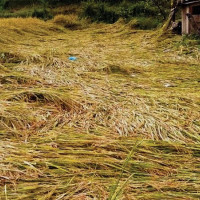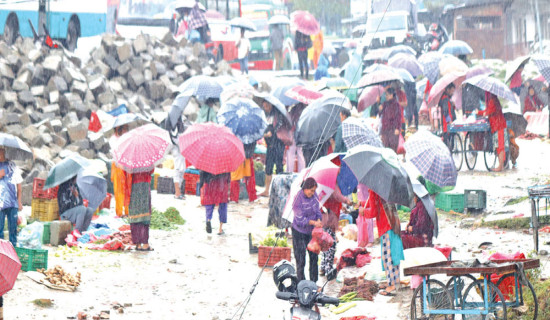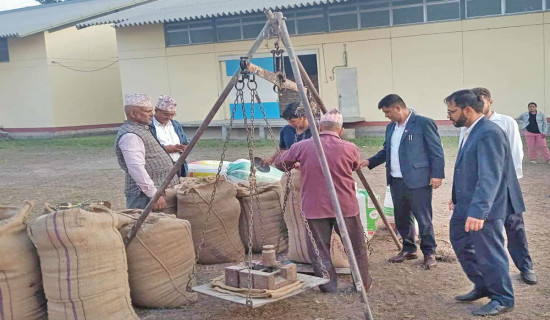- Sunday, 9 November 2025
Nepal makes record-high exports
Kathmandu, June 23: Nepal’s export sector has achieved a historic milestone, touching highest-ever export value of nearly Rs. 250 billion in the first 11 months of the current fiscal year 2024/25.
According to trade statistics made public by the Department of Customs, goods worth Rs. 247.57 billion have been exported during the first 11 months (mid-July to mid-June) of the current fiscal year. This is 77.77 per cent higher than the export of corresponding period last fiscal year.
The country exported Rs. 139.26 billion worth of during the first 11 months of the last fiscal year. Earlier, highest-ever amount of Rs. 200.03 billion was exported in the fiscal year 2021/22. After that, the export of goods had dropped in the corresponding period of 2022/23 and 2023/24.
Goods worth Rs. 157.14 billion had been exported in the fiscal year 2022/23 and Rs. 152.38 billion in the fiscal year 2023/24.
Edible oil exports surge
The surge marks a significant development in the country's external trade, buoyed primarily by increased shipments of processed edible oils, particularly soybean oil and sunflower oil.
While this marks a positive trend, experts caution that this growth is heavily reliant on the export of processed edible oils derived from imported crude, rather than domestically produced goods.
The bulk of the export surge stems from soybean oil exports at Rs. 93.52 billion, while sunflower and palm oil exports stood at Rs. 11.33 billion and Rs. 1.99 billion respectively.
Soybean oil worth only Rs. 875 million was exported during the first 11 months of the last fiscal year. Likewise, palm oil worth Rs. 6.7 billion and sunflower oil worth Rs. 159 billion had been exported during the first 11 months of the last fiscal year. The export of palm oil has decreased during the review period.
Former secretary of the government of Nepal Purushottam Ojha has said that there was no reason to be happy with the growth of export seen in the recent months.
"The growth is heavily reliant on re-export activities rather than on goods produced from Nepal’s own raw materials. This is a positive trend for trade volume and foreign exchange earnings, but the sustainability of this growth is questionable,” said.
Export of processed edible oils —soybean, sunflower, and palm oils — alone constituted 43 per cent of total exports during the review period. The oils are processed domestically from crude oil imported mainly from countries such as Argentina, Ukraine, Brazil, Paraguay, Thailand, United States, and then re-exported to neighbouring markets, particularly India.
The country imported crude soybean oil worth Rs. 95.79 billion, palm oil Rs. 10.92 billion and sunflower worth Rs. 27.11 billion during the review period. “We need to focus more on promoting exports of products with domestic value addition," he said.
Ojha further highlighted a critical currency mismatch; Nepal spends US dollars to import crude edible oils, but earns Indian rupees from their re-export. With over 95 per cent of soybean oil exports headed to India, this trade structure leaves Nepal vulnerable to policy shifts or market changes in either country, he said.
Stating that there is volatility in the export of edible oil for the past few years, he said that export of soybean and palm increased due to facilities under the bilateral trade agreement between Nepal and India. He, however, noted the growth in the export of tea and coffee, garment, cardamom, carpet is positive.
Senior Officer of Trade Statistics and Analysis Section, Trade and Export Promotion Centre Krishna Raj Bajgain stressed the need to make the current export growth sustainable.
"Of course, the significant increase in exports this year is due to the increase in exports of soybean and sunflower oil to India. Therefore, the government should take diplomatic initiatives to continue trade facilitation received from India to make export improvement sustainable," he said.
The export of edible oil is being done with at least 30 per cent value addition. Stating that no country exports goods that are produced only in its own country, he said that the export should be focused on value addition.
Similarly, the country exported tea and coffee worth Rs. 4.3 billion, cardamom worth Rs. 7.19 billion, carpet worth Rs. 10.8 billion, yarns worth Rs. 12.89 billion and woolen felt worth Rs. 4.6 billion.
Former secretary Ojha urged the government to pivot towards promoting home-grown industries with higher domestic value addition to ensure long-term sustainability in the export sector.
While the current surge in re-exports has boosted trade statistics, without strengthening the foundation of local production, Nepal risks continued vulnerability to global price volatility, trade policy changes, and currency pressures, he said.
Foreign trade, trade deficit up
Even though exports have risen significantly, the country's trade deficit has increased due to the higher volume of imports than exports. The country imported goods worth Rs. 1,644.79 billion during the first 11 months of the current fiscal year.
This is 13.15 per cent higher than import of goods during the first 11 months of the last fiscal year. According to the statistics, trade deficit increased by 6.30 per cent to Rs. 1,397.22 billion during the review period.
The country had faced a trade deficit of Rs. 1,314.44 billion during the first 11 months of the last fiscal year. Similarly, the country’s foreign trade volume has reached Rs. 1,892.67 billion during the review period which is 18.80 per cent more than the previous year.
Even though exports went up significantly, the ratio of export to import is still 1:6.64. The ratio of export to import has decreased by 36.35 per cent during the review period as compared to the same period last fiscal year.
The share of export in the total foreign trade is only 13.08 per cent while that of import is at a whopping 86.92 per cent.
















